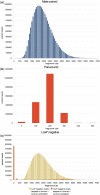Illumina mate-paired DNA sequencing-library preparation using Cre-Lox recombination
- PMID: 22127871
- PMCID: PMC3273786
- DOI: 10.1093/nar/gkr1000
Illumina mate-paired DNA sequencing-library preparation using Cre-Lox recombination
Abstract
Standard Illumina mate-paired libraries are constructed from 3- to 5-kb DNA fragments by a blunt-end circularization. Sequencing reads that pass through the junction of the two joined ends of a 3-5-kb DNA fragment are not easy to identify and pose problems during mapping and de novo assembly. Longer read lengths increase the possibility that a read will cross the junction. To solve this problem, we developed a mate-paired protocol for use with Illumina sequencing technology that uses Cre-Lox recombination instead of blunt end circularization. In this method, a LoxP sequence is incorporated at the junction site. This sequence allows screening reads for junctions without using a reference genome. Junction reads can be trimmed or split at the junction. Moreover, the location of the LoxP sequence in the reads distinguishes mate-paired reads from spurious paired-end reads. We tested this new method by preparing and sequencing a mate-paired library with an insert size of 3 kb from Saccharomyces cerevisiae. We present an analysis of the library quality statistics and a new bio-informatics tool called DeLoxer that can be used to analyze an IlluminaCre-Lox mate-paired data set. We also demonstrate how the resulting data significantly improves a de novo assembly of the S. cerevisiae genome.
Figures




Similar articles
-
Preparing Mate-Paired Illumina Libraries Using Cre Recombinase.Methods Mol Biol. 2017;1642:247-261. doi: 10.1007/978-1-4939-7169-5_16. Methods Mol Biol. 2017. PMID: 28815505
-
Preparing Fosmid Mate-Paired Libraries Using Cre-LoxP Recombination.Methods Mol Biol. 2017;1642:263-284. doi: 10.1007/978-1-4939-7169-5_17. Methods Mol Biol. 2017. PMID: 28815506
-
Generation of long insert pairs using a Cre-LoxP Inverse PCR approach.PLoS One. 2012;7(1):e29437. doi: 10.1371/journal.pone.0029437. Epub 2012 Jan 9. PLoS One. 2012. PMID: 22253722 Free PMC article.
-
Fine de novo sequencing of a fungal genome using only SOLiD short read data: verification on Aspergillus oryzae RIB40.PLoS One. 2013 May 7;8(5):e63673. doi: 10.1371/journal.pone.0063673. Print 2013. PLoS One. 2013. PMID: 23667655 Free PMC article.
-
Integrated analysis of whole-genome paired-end and mate-pair sequencing data for identifying genomic structural variations in multiple myeloma.Cancer Inform. 2014 Sep 21;13(Suppl 2):49-53. doi: 10.4137/CIN.S13783. eCollection 2014. Cancer Inform. 2014. PMID: 25288879 Free PMC article. Review.
Cited by
-
Summarizing specific profiles in Illumina sequencing from whole-genome amplified DNA.DNA Res. 2014 Jun;21(3):243-54. doi: 10.1093/dnares/dst054. Epub 2013 Dec 18. DNA Res. 2014. PMID: 24353264 Free PMC article.
-
Genome sequencing of Aspergillus glaucus 'CCHA' provides insights into salt-stress adaptation.PeerJ. 2020 Feb 24;8:e8609. doi: 10.7717/peerj.8609. eCollection 2020. PeerJ. 2020. PMID: 32140304 Free PMC article.
-
Sequencing and Optical Genome Mapping for the Adventurous Chemist.Chem Biomed Imaging. 2024 Oct 25;2(12):784-807. doi: 10.1021/cbmi.4c00060. eCollection 2024 Dec 23. Chem Biomed Imaging. 2024. PMID: 39735829 Free PMC article. Review.
-
Next-generation sequencing and large genome assemblies.Pharmacogenomics. 2012 Jun;13(8):901-15. doi: 10.2217/pgs.12.72. Pharmacogenomics. 2012. PMID: 22676195 Free PMC article. Review.
-
Draft genome analysis provides insights into the fiber yield, crude protein biosynthesis, and vegetative growth of domesticated ramie (Boehmeria nivea L. Gaud).DNA Res. 2018 Apr 1;25(2):173-181. doi: 10.1093/dnares/dsx047. DNA Res. 2018. PMID: 29149285 Free PMC article.
References
-
- Illumina. Mate Pair Library v2 Sample Preparation Guide For 2–5 kb Libraries. 2009.
-
- Roche. GS FLX Paired End DNA Library Preparation Method Manual, GS FLX Titanium Series. 2009.
Publication types
MeSH terms
Substances
Grants and funding
LinkOut - more resources
Full Text Sources
Other Literature Sources
Molecular Biology Databases

